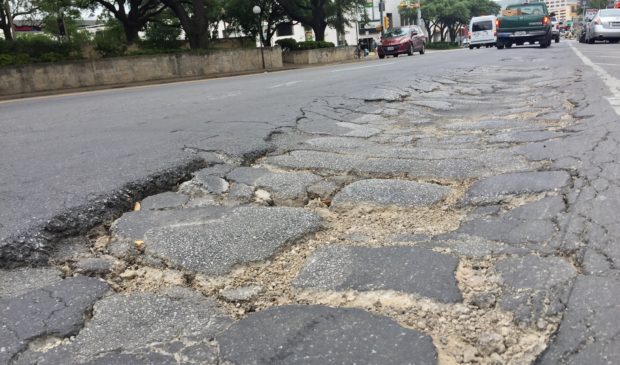City developing concrete plans to make bus passengers more comfortable
Wednesday, April 26, 2017 by
Caleb Pritchard If you close your eyes, you can imagine yourself raiding Berlin in 1943, the deafening explosions of flak violently rankling the thin fuselage that separates you from the battlefields below.
But in reality, you’re riding one of the hundreds of Capital Metropolitan Transportation Authority buses that grind across badly damaged Central Austin asphalt and turn a simple trip to the grocery store into a bone-grinding test of physical will.
The rough conditions on the Drag and along the dedicated bus lanes on Guadalupe and Lavaca streets are amplified on heavy buses with worn shocks and shaky interior fixtures, and create another obstacle to luring drivers out of the relative comfort of their cars.
It’s those same buses that are largely to blame for the problem.
Edward Poppitt, an engineer with the Austin Public Works Department, estimates that 365 buses per day converge on the stop in front of the University Co-op at Guadalupe and West 23rd streets. Further down Guadalupe, between 6th and 8th streets, as many as 450 buses are pounding the pavement each day.
“With that many buses in any one place, it’s an extensive amount of wear and tear on the roads,” he explained to the Austin Monitor.
The punishment ramped up in 2014 when Capital Metro rerouted most of its downtown routes off of Congress Avenue and onto the dedicated bus lanes along Guadalupe and Lavaca streets. Poppitt said his department underestimated just how brutal the buses would be on the asphalt surfaces.
“We didn’t expect it to go as fast as it did. It’s been a learning experience for us,” Poppitt said. ”We’re gonna have to play some catch-up here and try to get some more robust pavements on those areas that are just going to deteriorate much faster than expected.”
The long-term solution appears to be replacing the crumbling asphalt with concrete, a much more durable material. Eight years ago, the city opted to pave the stretch with cheaper asphalt partly due to its price and partly to planning uncertainties. At the time, there were still questions about possible light rail routing down Guadalupe Street.
The “preferred concept” in the Guadalupe Street Corridor Improvement Program – which will ultimately be funded with money approved by voters in last year’s mobility bond referendum – calls for the continuation of bus lanes on the outside of the Drag between West 29th Street and Martin Luther King Boulevard.
Installing concrete lanes along that stretch would cost an estimated $1.1 million, while laying concrete in one lane each direction from 29th Street to Cesar Chavez Street would likely run as high as $5 million.
The price of concrete, Poppitt said, is more comparable to asphalt than it has been in the past, due to rising petroleum costs. Also, concrete’s decades-long lifespan makes it even more cost-effective in the long-term.
The department has not yet identifed a funding source for the complete work, and the ramp-up to prepare for the massive list of bond projects that City Council pledged to deliver in eight years has taken up much of the planning oxygen lately. However, Poppitt insisted that business as usual won’t be lost by the wayside.
“The bond program is not going to drown out or snuff out everything else and become the only focus,” he promised.
While plans for laying concrete lanes continue to simmer, Poppitt said that crews are prepared to execute spot repairs on the most damaged sections of any city street and invited residents to report problems via 311.
In the meantime, Capital Metro is putting up its own money to pour its concrete bus pads in front of three stops: one on the southbound lane of Guadalupe in front of the University Co-op, one at Guadalupe and W. 17th streets and one on the southbound side of North Lamar Boulevard and Sunshine Drive. The estimated cost of those installations is $141,600.
Photo by Caleb Pritchard.
The Austin Monitor’s work is made possible by donations from the community. Though our reporting covers donors from time to time, we are careful to keep business and editorial efforts separate while maintaining transparency. A complete list of donors is available here, and our code of ethics is explained here.
You're a community leader
And we’re honored you look to us for serious, in-depth news. You know a strong community needs local and dedicated watchdog reporting. We’re here for you and that won’t change. Now will you take the powerful next step and support our nonprofit news organization?



